Anime Genres And Their History
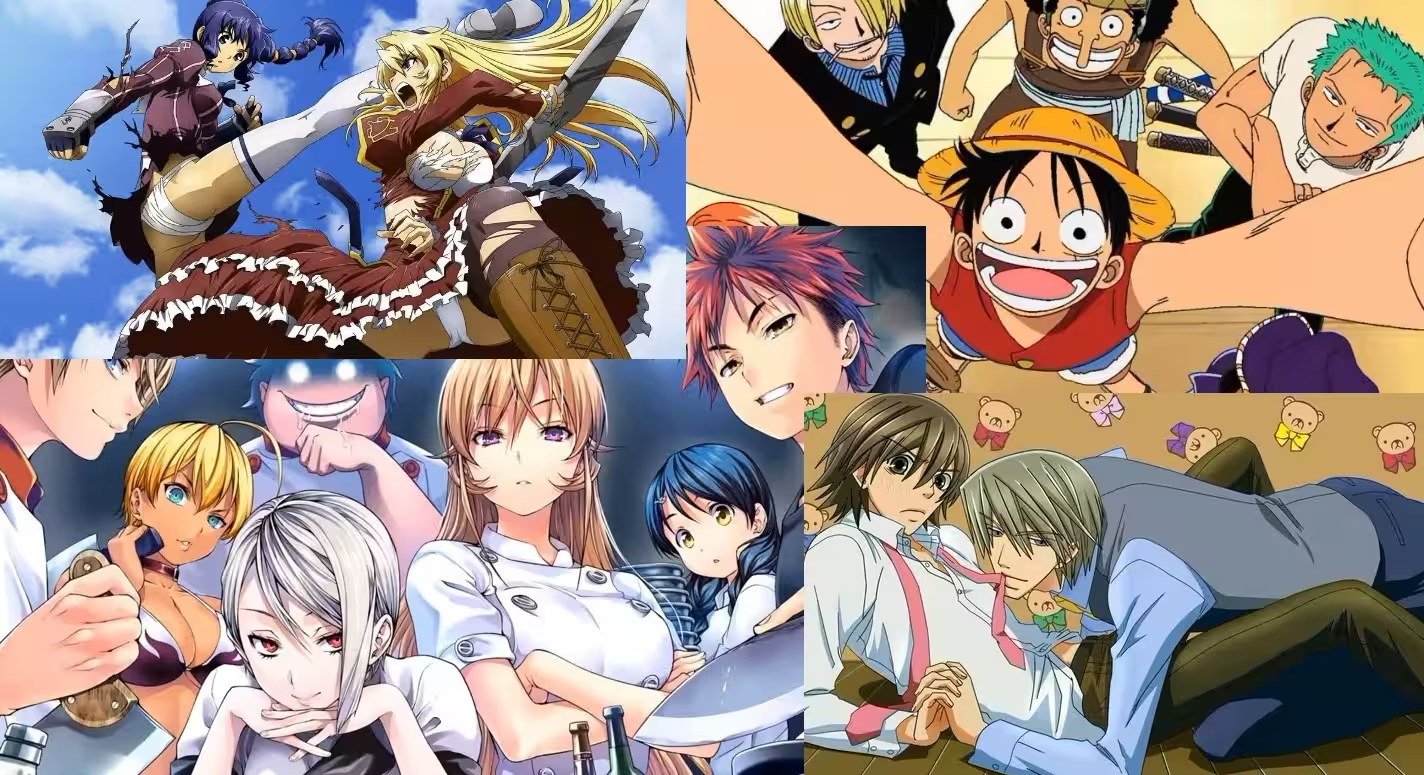
Understanding of Anime:
Animes cover a wide range of topics for all ages. Stories are often more complex and multi-layered than in many western animated cartoons. There is more character development, and even the death of important characters loved by the audience occurs.
For heroic characters, their motivation, loyalty, and assertiveness are more important than winning, and anti-heroes appear more often. Also, historical heroes like the ninja or samurai (Bushidō) are reflected in many animes. A classic conflict from this tradition is giri-ninjō, the conflict between social obligation and personal needs.
Antagonists are often differentiated and have a background story that explains their actions. The more frequent change of sides of a character also contributes to this. Clichés about typical villains get broken, and for example, especially the antagonists are portrayed as particularly lovely.
Women often have more important roles, are strong heroines equally to men, and yet are usually portrayed attractively. Even though, or maybe because this often still doesn’t reflect the position of women in Japanese society, it contributes to a broader audience.
Nevertheless, traditional female roles can often be identified. These include the role of mother and (in the background) caring housewife or the quiet, cute, empathetic schoolgirl. These roles can be described with the Japanese term “yasashii” (pure, warm, empathic). They also include warriors, who associate yasashii with the ideals of Bushidō, and girls and women with magical powers.
Questions about sexuality and gender are often treated in anime, casually, and with perspectives that are unusual for western viewers, and are the subject of comedy, clichés and erotic stories. Homosexuality appears explicitly and even more frequently in the form of hints, as well as blurred gender roles and androgynous figures, which also appear in ideal images such as men being Bishōnen or repeatedly appearing women in “men’s” roles.
Homosexual behaviour is often not an identifying trait of the characters; they do not even understand themselves as homosexual or are characterised by many other traits and can appear in the most diverse roles. Stories about same-sex love are dedicated to whole genres.
Nevertheless, even in stories about same-sex love, conservative values are sometimes conveyed. Especially in older works, the relationships find a tragic end, and the protagonists are punished for violating social norms.
While television productions are more often aimed at children, the target group of the video market is older teenagers and adults. As a whole, anime can appeal to all age groups and social classes.
Following the usual classification of manga into target groups according to age and gender, anime often does the same. However, with many animes, especially those without a manga template, the classification into these genres is difficult or even impossible.
Main-Genres in Anime
Kodomo (Jap. for “child”)

© Nippon TV
At the beginning of modern manga after the Second World War, almost all series were aimed at children, and there were, therefore, fewer magazines aimed explicitly at children. One of the first was The Kodomo Manga Shimbun from 1946. From the 60s onwards, an older audience was gradually addressed, so that from the 70s onwards, separate magazines were established for children only. The most important of these is CoroCoro Comic, which also published Doraemon, one of the most important series of the genre.
Another major magazine is Comic BomBom, which, however, was discontinued in 2007. Before there were manga magazines for children, Kodomo was mainly published in mixed magazines, in which comics were only one part and which also offered a lot of educational content. Since the 90s, Kodomo manga itself has been used more to convey education and upbringing, for example, by adapting fairy tales and children’s book material or biographies.
Kodomo refers to a genre of anime and manga, which are aimed specifically at children up to middle school age. In contrary to series for an older audience, such as Shounen for boys and Shoujo for girls, there is no separation of the target group by gender in the Kodomo genre.
Examples of the Kodomo genre are Doraemon, Hamtaro, Pokemon and Dr. Slump.
Shounen (Jap. for “boy”)
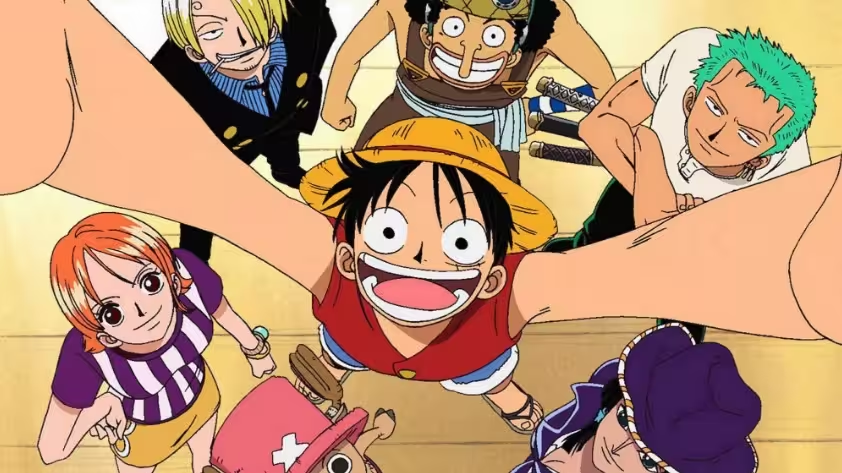
© Toei Animation Co., Ltd.
Shounen means “youth” or “boy” in general and was used in this sense for children and youth magazines at the end of the 19th century. The classification of the market, especially of manga magazines, according to gender and age-specific target groups has been established since the beginning of the 20th century – especially since the 60s. The similar term Bishōnen refers to the depiction of a handsome young man according to the Japanese ideal, which is particularly common in Shoujo manga and anime.
Shounen refers to a category of Japanese comics and animated films, manga and anime, aimed at a young male audience. Shounen is the most popular genre in the Japanese market. The related category for a slightly older male audience is Seinen. This genre classification, according to target groups, is because most mangas in Japan appear first in manga magazines, which specialize in demographic groups.
The focus of Shounen is mainly on action, adventure, war, and the fight against monsters and evil forces. Therefore, some works are not assigned to Shounen because of their target group, but only because their main focus is action. Within the Shounen category, there is a wide variety of content and a multitude of genres and subgenres despite the thematic focus. In comparison with comic cultures outside Japan, the category offers the greatest thematic diversity for its target group.
This includes crime stories, comedies, love stories, romantic comedies, and stories about hobbies such as sports and games of all kinds, as well as the everyday life of many occupation groups. However, the main theme is almost always a rivalry between the protagonist and his/her opponent. The very dominant action genre presents itself in all kinds of settings, from realistic historical or contemporary depictions to fantasy or science fiction.
Examples of Shounen animes are One Piece, Naruto and Hunter x Hunter.
Shoujo (Jap. for “girl”)

© J.C.Staff Co., Ltd.
From the beginning of the 20th century, the first comics for girls appeared in Japanese girls’ magazines such as Shoujo Club. These were drawn by men and were still conceived as “Yonkoma Manga“, as entertaining comic strips. For example, in 1949, Shōsuke Kuragane created the comic strip series Anmitsu-hime for the monthly magazine Shoujo.
However, girl manga only became successful in the form of long comics with a continuous plot, in the form of story mangas. The first story manga for girls was created by Osamu Tezuka between 1953 and 1958 with Ribon no Kishi for Shoujo Club. Other male illustrators also created Shoujo-Manga after the model Ribon no Kishi in the 50s, often because they were not accepted in the Shounen genre.
Frequently treated topics in the Shoujo genre are first love, lovesickness, and friendship. Known Shoujo animes are Alpen Rose, Glass Mask and Maid Sama!.
Seinen (Jap. for “young man”)
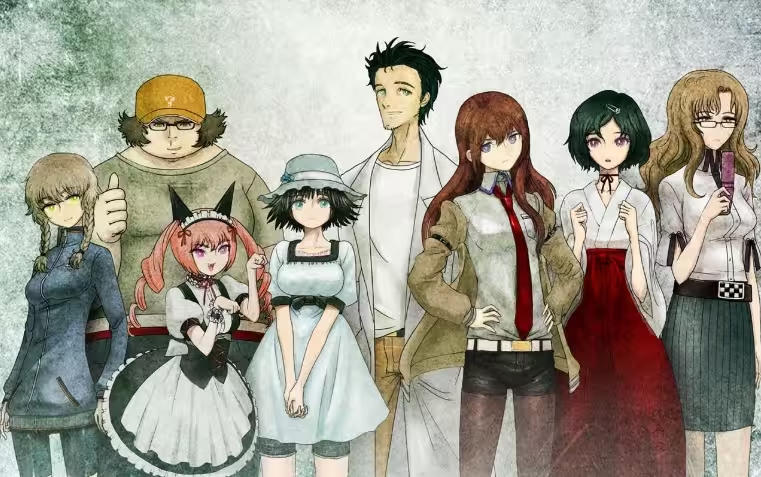
© White Fox Co., Ltd.
The Seinen genre developed around 1970 from the trend of the Gekiga Manga. Since the 50s, this movement had been producing serious stories, often on socially critical themes, in a more realistic drawing style for an adult audience.
Manga Action is considered to be the first Seinen-Manga-Magazin, which was published from 1967 on and contained among others the successful series Lupin III. The magazines Young Comic (1967), Play Comic (1968), and Big Comic (1968) followed. The success of these magazines affected the already older Shounen magazines, which now also offered series for an older audience.
According to cultural historian Tomafusa Kure, the Seinen genre also gained readers because, during the same period, Japanese literature increasingly focused on psychological states and moved away from narrative clarity and plot-driven stories, losing the interest of most readers.
Primary target group are men between 18 and 30 years of age, usually with more demanding, erotic or violent content. In terms of content, the Seinen genre covers a broad spectrum and cannot be confined to individual genres. A large part of the stories deals with the everyday life of specific professions. Thus, the manga and anime specific genre Gourmet, which deals with cooking and eating, is strongly represented.
Sports series and those about hobbies are also common. At the same time, action is an important element of the plot. Also, some series and magazines offer a lot of action and eroticism, as well as crime stories, historical material, dramas, and thematisation of social problems.
Examples of the Seinen animes are Steins;Gate, Knights of Sidonia and Monster.
Josei (Jap. for “woman”)

© Madhouse Inc.
At the end of the 60s, when Seinen-Mangas for adult men (like Golgo 13) became very popular, a few pages of comics were included in some women’s magazines for the first time. However, these hardly attracted any attention and were created by rather unknown female illustrators. Manga magazines dedicated exclusively to publishing comics for adult women first appeared in 1969. The magazines, which were intended as experiments, were failures and were canceled after a short time.
The first Josei successes didn’t appear until the early 80s. Manga magazines like “You” and “Be Love” were founded. Famous shoujo mangaka, like Riyoko Ikeda drew the first successful Josei mangas.
Josei is the female counterpart of Seinen. While the Shoujo genre is aimed at pubescent girls, the Josei genre is designed for adult women who already have a love life or professional life. Most Josei titles are realistic and deal with experiences from work, family, interpersonal relationships, or stories about pets.
They are mostly drawn by female mangaka.
Examples of Josei animes are 07-Ghost, Chihayafuru and Usagi Drop.
Sub-Genres in Anime
Even though basically all kinds of topics can occur, especially those related to Japanese everyday life or Japanese culture are common. These can be sports and art, problems of everyday life and its rules or living in a modern, technological and densely populated country, as well as traditional arts, topics of Buddhism and Shinto and Japanese history and mythology.
Traditional stories, which include not only mythology but also Japanese classics such as Hakkenden and Genji Monogatari, are often used, modernized and presented in a contemporary interpretation. Non-Japanese, especially Judeo-Christian symbolism and Chinese mythology, are also repeatedly included.
Also, there are typically Japanese subjects such as mono no aware, which can express themselves not only in aesthetics but also in the stories as such. These themes are often mixed with science fiction, and fantasy elements and most of the works cannot be clearly assigned to a single genre.
Besides that, there are typically Japanese and in anime widespread themes like advantages and conflicts in a closed society and as a counterpart the tempting, free but also dangerous life of misfits and loners.
In addition, there are political themes such as appreciation of nature, environmentalism, war and peace. Also, to the internationally better known pacifistic works in fantastic, realistic, or dystopian settings, some stories take up the war propaganda of World War II or play down Japanese imperialism and emphasize a Japanese victim role in the war.
From literary adaptations (e.g. The Diary of Anne Frank or Heidi) to horror, comedy and romance, almost all areas and age groups are covered. The works can impart knowledge about history, a sport or another thematic focus of an anime, as well as teach moral values such as teamwork or respect. Some genres occur exclusively in anime and mangas or were created in these media.
Ecchi (Jap. for “naughty”)
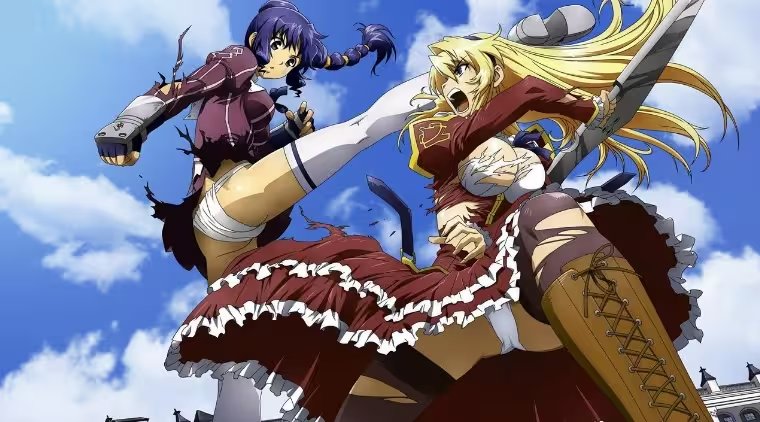
© A.C.G.T Inc.
The word was part of the jargon of Japanese high school girls during the 50s and is the pronunciation of the letter H – derived from the English pronunciation of H. The origin is not precisely known, and there are several common theories:
- It is assumed that Ecchi is the first letter of the Japanese word hentai in Latin script, which denotes many things that are considered sexually offensive under the standards of society generally accepted in Japan.
- Another theory is that the H derived from the first letter of the word harenchi (“impudence”, “shamelessness”), and has been used in the colloquial language of younger people since the 60s.
- But it is also not excluded that Ecchi derived from the first letter of the word himitsu (“secret”). It became known in 1952 in the treatise Shiroi Magyo by Seiichi Funabashi and was taken up again in the 90s, in relation to the sexual act itself. Thus, the comedian Sanma Akashiya is repeatedly mentioned in the context of having contributed to the spread and popularization of the coinage.
Hentai and Ecchi are often used separately in the West. Unlike in Japan, where they are used as general, equivalent terms for “naughty” and “perverse”. In the West, however, the two words represent different genres of manga and anime with sexual content. It has established itself to differentiate the terms according to the hardness of the portrayal: Ecchi usually refers to soft-erotic manga and anime. In contrast, the term hentai stands for pornography.
In Ecchis, contrary to Hentai, the topic of sexuality is treated rather humorously. The depictions often show cute figures who are not aware of their sexual attraction, are usually joyful, and appear innocent (childlike). But the opposite is also possible. Thus, characters are also often depicted as serious, sophisticated, and conscious of their sexual attraction.
The Ecchi genre has a young target group. Most of them are male and under 18 years of age, but sometimes Ecchis are also very demanding and less humorous, which should appeal to an older target group.
Examples of Ecchi animes are The Qwaser of Stigmata, Heaven’s Lost Property and KissXSis.
Gourmet

© J.C.Staff Co., Ltd.
One of the first series was the manga Hōchōnin Ajihei from Jirō Gyū and Jō Big, published from 1973 to 1977. Even before that, cooking played a role in mangas. For example, in Sazae-san, a series about a housewife that has been published since 1946. But the topic was not the focus for a long time. Tekka, no Makihei from Yūichirō Ōbayashi and Yasuyuki Tagawa, was the first manga to introduce the competition aspect, in which the young sushi chef competed against other students.
One of the first action cooking manga is considered to be Mikiya Mochizuki’s Totsugeki Rāmen from 1970. During the peak of the economic boom in Japan in the 80s, a “gourmet trend” emerged that led to the popularization of the genre. The longest-running and most successful series is the manga Oishimbo, which has been published in Big Comic Spirits magazine since 1983.
In animes of the gourmet genre, a usual chapter or episode focuses on one dish and its preparation. The story of a series often follows a pattern that is common in the Shounen genre, which is aimed at young men. It shows the rise of a misfit in the world of profession or hobby, in this case, the cook, gourmet, or detractor, who eventually becomes or wants to become the best in his job. The young chef is usually apprenticed to a master, and, according to the Japanese teaching tradition Shugyō, he learns mainly by observing and imitating the master.
Some series also introduces the aspect of competition, in which the protagonist competes with his opponents in his profession. Also, to the actual plot and the conflict about cooking, the series often offer the audience tips and hints about cooking, including recipes to cook afterward. In addition to the series on professional cooks, there are also those devoted to housewives or men, which provide a simpler, more everyday approach to cooking.
The target group, as well as the authors, are mostly young men. Many of the series are accordingly to be assigned to the Seinen genre. But also works for a younger or female audience, i.e., Shounen or Shoujo-series, are represented. Stories aimed towards a female audience are more concerned with desserts and are designed as love stories.
Examples of Gourmet animes are Chuuka Ichiban!, Toriko, and Food Wars!.
Harem
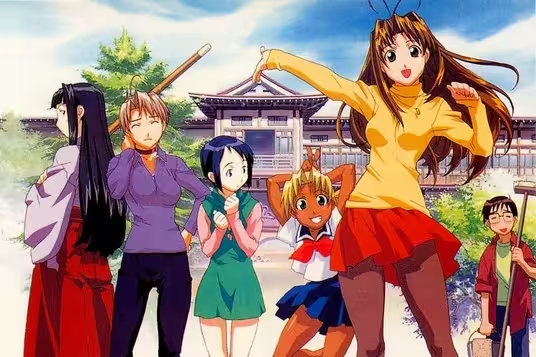
© Xebec, Inc.
The term itself is derived from the Arabic word “harem” and has been adopted into Japanese usage. Here, however, it was not used in its original meaning (“women, taboo, holy”) in connection with anime and manga, but was extended to a general relationship situation. Eventually, the term also spread in the English-speaking countries and gradually became a genre term.
Manga and anime, which make use of this genre, are repeatedly criticized for being cheap “bulk goods”, because they would copy too much of each other. Many of them are said to rely on blatant fan service and lack of a sophisticated plot. At the same time, this type of anime is not supposed to have a high status among the female audience, as they see it as a sexist misinterpretation of girls and women. Nevertheless, the reasons for this are not directly seen in the genre, but solely in the quality of the works themselves.
Harem is a genre in which the protagonist of the plot is surrounded by several or even a multitude of other characters of the opposite sex who are attracted to him/her.
Examples of Harem animes are Love Hina, Haganai: I don’t have many friends, and Saekano: How to Raise a Boring Girlfriend.
Hentai
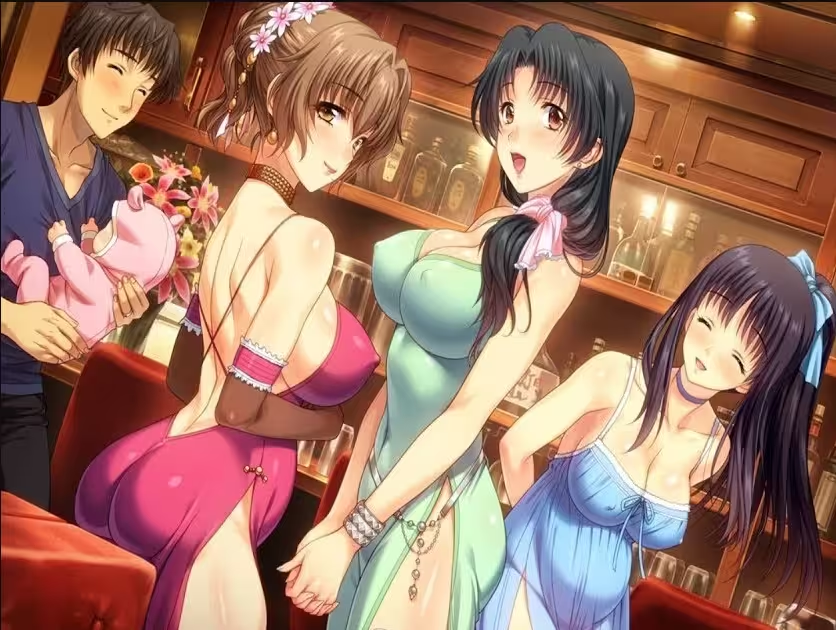
© Amour
Western viewers mainly use this term for anime with pornographic or erotic content. In Japan, however, the term poruno is commonly used to refer to such material.
The word hentai is a kanji compound of 変 (hen; “change”, “weird”, or “strange”) and 態 (tai; “attitude” or “appearance”). The term is used as a shortened form of the phrase 変態性欲 (hentai seiyoku) meaning “sexual perversion”. (Source)
Early examples of sexual portrayals imported into the West came mainly from the horror genre, e.g., Urotsuki Dōji, in which monsters rape young girls with tentacles. Also, unusual practices and fetishes are often depicted, such as bondage and voyeurism.
Terms and sexual fetishes in Hentai:
- Yaoi: homoerotic depiction of (mostly rather feminine) men.
- Bara: homoerotic depiction of masculine men.
- Bakunyū: the depiction of women with large breasts.
- Futanari: the depiction of hermaphrodites or female intersexuality.
- Incest
- Lolicon
- Shotacon: the erotic depiction of prepubescent boys.
- Omorashi: erotic satisfaction due to the sensation of a full bladder.
- Netorare: “stealing” others their partner.
- Tentacle erotica: the depiction of creatures with tentacles and sometimes fictitious imaginative or other creatures that have sex with girls and less often with men or practice sexual abuse.
- Ahegao: a facial expression of fictional characters in pornographic video games, mangas and animes during sex.
The Japanese concept of obscenity is quite different from that of other cultures. Even children’s anime can contain naked characters, such as in Sailor Moon, where the characters are shown naked during their transformation in a non-sexual context.
Hentai anime accounts for five to ten percent of all animes produced in Japan. Many Hentai animes can also be assigned to other genres like fantasy, science fiction, or magical girl.
Examples of Hentai animes are Pretty x Cation The Animation, Wife Eater 3, and Amakano.
Isekai (Jap. for “other world”)

© Kinema Citrus Co., Ltd.
The concept of the Isekai genre goes back to Lewis Carrolls’ “Alice’s Adventures in Wonderland“, published in 1865. Other Western works have also adopted the same concept, such as Peter Pan, The Chronicles of Narnia, The Neverending Story, and The Wonderful Wizard of Oz, which are considered Western examples of the genre. Since then, this concept has been further developed.
Shōsetsuka ni Narō, a Japanese web-novel-website on which many recent Isekai works originated before being revised by publishers as light novels and then adapted as mangas and animes, distinguishes between two categories in this genre – isekai ten’i (transition into another world) and isekai tensei (rebirth/reincarnation into another world).
The former was common for early Japanese titles that can be classified into the genre, such as El Hazard and Fushigi Yuugi, in which the protagonists were transported alive to another world. In later works after the turn of the millennium, such as Knight’s and Magic or Saga of Tanya the Evil, the protagonists died in the real world and were reborn in another world.
The first works that can be assigned to the Isekai genre featured female protagonists, such as Fushigi Yuugi or The Vision of Escaflowne from the 90s. This changed in the early 2010s, and the protagonists tended to be male. Since then, the characters who are transported or reborn in another world have mostly been Hikikomori, NEETs, Otakus, or gamers who see the new world as a wish-fulfillment.
In this world, they can – in contrast to life in reality – be successful through their video game experience. Often video game worlds are also used as a theme for another world (e.g., Log Horizon or Sword Art Online). Also, more recent works aim at the fulfillment of sexual desire, so that many recent Isekai animes collide with other genres such as the Harem and Ecchi. Isekai animes has gained popularity in recent years and has evolved from a female Shoujo target group in the 90s to a more male Shounen target group.
Examples of Isekai animes are Sword Art Online, The Rising of the Shield Hero and Log Horizon.
Magical Girl

© Madhouse Inc.
The first Magical Girl, as well as Shoujo anime, is Mahō Tsukai Sally, which was broadcast from 1966 to 1968 and was based on the manga of the same name by Mitsuteru Yokoyama, who was inspired by the US sitcom Bewitched. However, Magical Girl mangas existed before that, like Himitsu no Akko-chan by Fujio Akatsuka, which was published between 1962 and 1965.
In 2004 the series Mahō Shōjo Lyrical Nanoha was released, which uses the same style as previous Magical Girl series, but shows physical violence and is aimed at an older male audience. Puella Magi Madoka Magica, also by Akiyuki Shimbō, takes up the genre but turns it upside down with its dark plot and adult themes.
A Magical Girl is a young female character (Bishōjo) who gains supernatural powers through a special item and whose destiny is to fight against dark forces. In addition, the character often has minor character flaws, such as clumsiness and everyday problems with which she has to struggle alongside the main plot. Typical for the Magical Girl genre are repetitive transformation sequences as well as playing with the resulting multiple identities.
One of the most important works of the genre is Sailor Moon.
Examples of Magical Girl animes are Cardcaptor Sakura, Magical Girl Lyrical Nanoha, and Revolutionary Girl Utena.
Mahjong
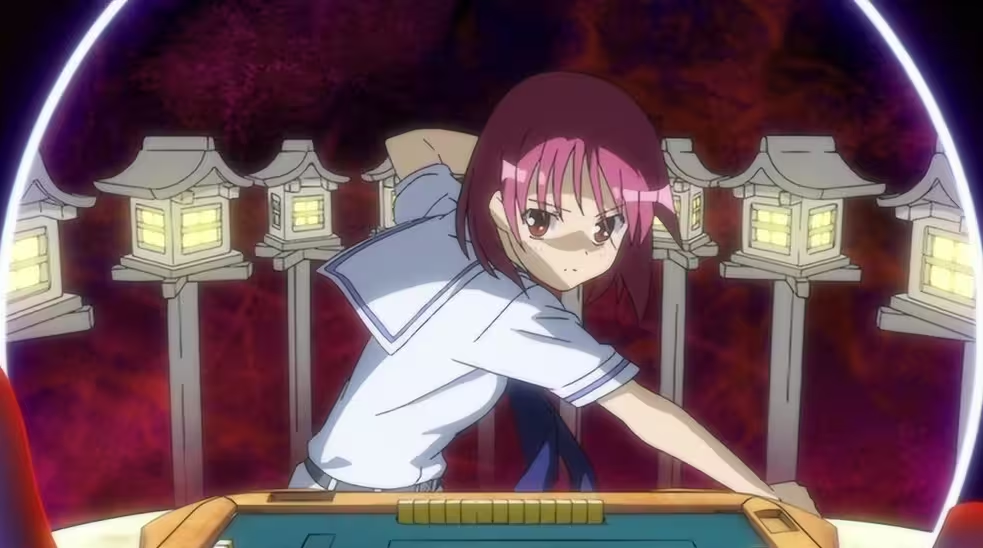
© Gonzo K.K.
The game is particularly popular in Japan as a gambling game, although it is illegal. Out of this popularity arose, besides mangas about other gambling games, the genre of mahjong mangas, to which own magazines were dedicated since the 70s. In the 80s, up to seven magazines appeared, each with a monthly circulation of about 150,000 copies. They contain short stories, sequels, and articles about Mahjong.
The first Mahjong manga was Mājan Hōrōki by Takehiro Irokawa, under the pseudonym of Tetsuya Asada, and Eimei Kitano in 1975. Other sports and games were already being addressed in mangas in earlier decades, but Mahjong was long considered too static to be realized as a comic.
The stories mostly deal with the development of a Mahjong player from a beginner to a master of the game. Various aspects of Mahjong can be added, such as love stories, hentais, dramas, or family-friendly versions. The game is often depicted unrealistically, Mahjong pieces fly through the air or react to the players’ words.
The target group is mainly working men, who often do not have the time to play Mahjong themselves.
Examples of Mahjong animes are Akagi, Saki, and Legendary Gambler Tetsuya.
Shounen Ai (Jap. for “boy love”)
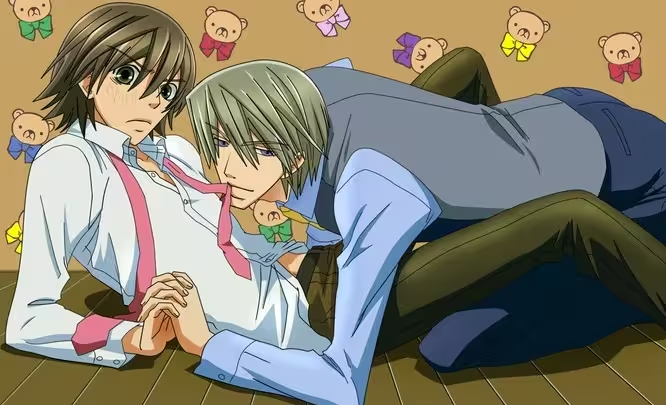
© Studio Deen Co. Ltd.
In Shounen Ai, emotions and development of the relationship between male characters are in focus; explicit erotic depictions do not occur. The first work of the genre was Moto Hagios Manga Tōma no Shinzō, which was released in Japan in 1974. The protagonists are usually based on the ideal of Bishōnen (ideal of a good looking boy).
However, the definition and distinction of the genre are not clear, even outside Japan. It can also stand for any homoerotic anime or manga with male protagonists and thus include yaoi, or it can only denote the early works of the 70s and 80s, which are set in exotic, often historical, European settings.
The main target group is not homosexual men, but girls and women. Almost all authors of the genre are also female mangaka. Theories of why Shōnen-Ai stories appeal to female readers and artists often assume that female readers are shy of erotic depictions of men and women. Japanese researcher Megumi Yoshinaka concluded that “adolescent girls are extremely picky”. Other theories suggest that the genre gives readers the possibility of fantasizing about the opposite sex without having to compete with a female character.
Despite the depiction of homosexual relationships, not all works and artists of the genre have a positive view of homosexuality. Especially early works represent in their stories an unhappy, unfulfillable love and can also be interpreted as an expression of reluctance towards actual homosexuality. Accordingly, the genre is not necessarily used for social or political messages, but mainly for erotic fantasies.
Examples of Shounen Ai animes are Junjou Romantica, Gakuen Heaven, and Love Stage.
Sports

© Production I.G. Inc.
Since early on, sport has been a theme in Japanese animation. In the 20s, as the number of short films produced increased, the first sports-related animated film was created in 1928 with Dōbutsu Olympic Taikai. The Anime Encyclopedia calls it the first sports anime. Sport, especially international competitions, was a theme that was considered modern and, at the same time, conveyed traditional values.
After the Second World War, under the American occupation, all Japanese sports and their theming were initially banned. These, mostly martial arts and related sports, were suspected of having contributed to militarism. Instead, American sports were promoted, which was very successful. The first post-war anime about sports, Dōbutsu Daiyakyūsen from 1949, was about baseball. In the 60s, the genre became more successful, partly because of the general enthusiasm for sport at the 1964 Summer Olympics in Tokyo.
In sports animes, usually, the development of an athlete is followed from the beginning to a professional career. The genre uses the respective sport as a metaphor of human aspirations and proving oneself to the challenges of life. The plot can also be interpreted as Japan’s self-perception as a country that, despite having fewer resources, stands up to its neighbours through ingenuity and persistence.
Examples of Sport animes are Kuroko’s Basketball, Captain Tsubasa, and Haikyu!!.
Yaoi

© Studio Deen Co. Ltd.
The term yaoi is an acronym for the Japanese expression “yamanashi ochinashi iminashi”, which in English means “without [narrative] highlight, without a punchline, without meaning”. Many yaoi authors don’t claim to build a supporting plot or to show the development of the characters. The focus is on the depiction of homoerotic love relationships and explicit sexual acts, typical for this genre.
Yaoi is a genre of manga, anime, and fanfictions that deals with homosexual relationships between male protagonists with explicit erotic depictions. In this aspect, the genre differs from Shounen Ai, where the focus is not on eroticism but the development of the romantic relationship. Since about 2000, the genre found many Western followers and imitators due to the growing popularity of anime outside Asia.
Yaoi-Manga are mainly drawn and read by younger women, who self-ironically call themselves Fujoshi (“spoiled girl”) – a pun with the homophonic Fujoshi (“woman”). Novels of the genre are also popular among an older audience. For these “mature” Fujoshi, the term Kifujin (“noble, spoiled woman”) – a pun with the homophonic Kifujin (“noble lady”) – has become established. Male readers of Yaoi call themselves Fudanshi (“spoiled boy”).
Examples of Yaoi animes are No Money, Hybrid Child, and Boku no Pico.
Mecha

© Production I.G, Inc.
Mecha derived from the ancient Greek stem, “mechos” (“means” or “possibility”) evolved the Greek word mechanes ( means, tool, or war machine) and the Latin machina (machine). From there, the English word mechanical developed, among others, which eventually became the Japanese word mecha.Mecha generally refers to mechanical objects of all kinds, from cars to machines and firearms to computers.
Animes in which robots or fantastic machines appear. These are often huge and are controlled by pilots sitting in them.
Examples of Mecha animes are Gargantia on the Verdurous Planet, Gurren Lagann, and Neon Genesis Evangelion.
[ays_survey id=”2″]